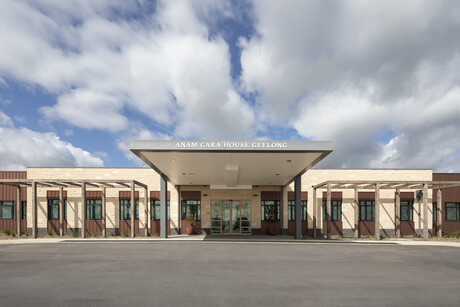When Anam Cara – a Geelong-based community service supporting people with life-limiting illnesses – outgrew its previous four-bedroom facility, its vision for the future was clear. Challenging traditional hospice concepts and creating “something very special” for the community.
Since the project began more than six years ago, the team at Tectura Architects worked closely with the team at Anam Cara to collaborate with ACHG board staff, families, community organizations, volunteers, specialists and contractor Nicholson Construction to bring the project to life – all of them were united in their vision of providing dignity and choice to people at the end of their lives.
“The brief was clear: to build a Class 9A hospital in the most dignified, homely environment possible. The architectural response has transformed the philosophy of palliative care, moving from a physical and pragmatic perspective to one that embraces emotional and spiritual intangibles. In other words, Tectura delivered a new healthcare model based on guest-centered care rather than a medical or clinical basis,” said Melika Grigg-Baycan, director of Tectura Architects.
Located on the beautiful grounds of Deakin University in Waurn Ponds, the 20-bed Anam Cara House was made possible with the support of the local and philanthropic community, as well as grants from the Victorian and Australian Governments.
Key features of the project include: 20 en-suite guest rooms – large enough to accommodate families and pets; hidden special equipment in the carpentry to feel like a real home; shared kitchen, living and dining areas; day palliative care area; library and community resource center; community office; spiritual area for cultural, faith and religious needs; and landscaped gardens, outdoor areas and walking paths.
“The 2-hectare site sits on historic land traditionally owned by the Wadawurrung people and offers beautiful views of the valley below. At every opportunity, this connection to the land is valued and celebrated as a foundation for care,” said Grigg-Baycan.

“The building features two long, linear wings that work with the gentle contours and slope of the site – the community center and infrastructure wing is busy and offers expansive views to the north. The more private residential wing with beds is to the south and offers views of the surrounding hills and valleys.
“The shape of the wings is an architectural expression and symbolizes the shape of the Anam Cara logo – a pair of caring hands. They house the nursing activity and gardens within, house a central library and connect courtyards while a garden winds around the building,” said Grigg-Baycan.
Openings and connections are designed so that each guest can feel – not patiently – the therapeutic benefits of the sun and fresh air on their skin, where they can walk or roll outside and feel connected to nature, looking at the horizon and on the Explore rolling hills and enjoy the feeling of the building enclosing them in a supportive manner.
“Inside, the mass of the building is divided into groups to create a family-friendly, human scale for all the people inside. The hallways don’t feel like hospital thoroughfares, while the interiors feature carpets, soft lighting, and wood details. The day services are well attended and offer community, resource and therapy services, while the quieter residential areas are separate and enhance privacy through careful zoning and planning to create a mix of intimate and semi-private spaces. Here the bedrooms are deliberately more spacious and equipped with materials that feel soft, light and warm, making for a homely space.
“Seamless wood joinery cleverly conceals lifting equipment and medical equipment. Care and comfort are conveyed through shared experiences and simple activities, which inspired the design of the adjacent shared lounges, kitchens and outdoor areas for guests and families. Guests can stay in their bedroom, read in the library, enjoy a family-prepared meal or go outside in the garden – the choice always comes first.
“Designed by the community, for the community, this is a project about human dignity and caring for our most vulnerable,” said Grigg-Baycan.
“In other words, we have developed a new healthcare model based on guest-centered care,” said Elizabeth Grigg, director of Tectura.
